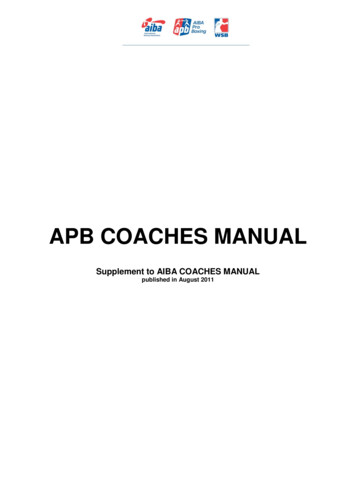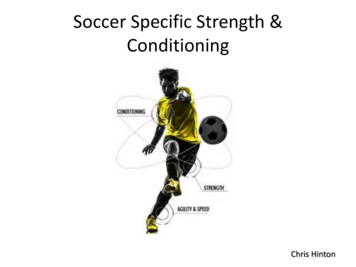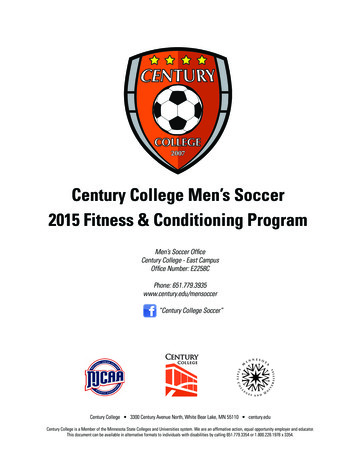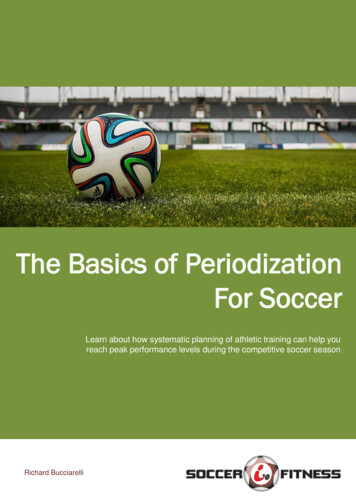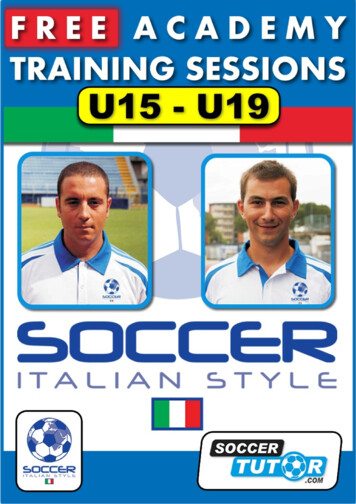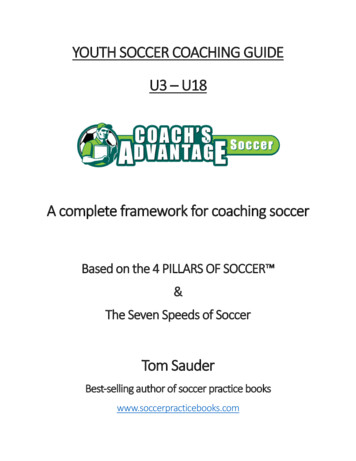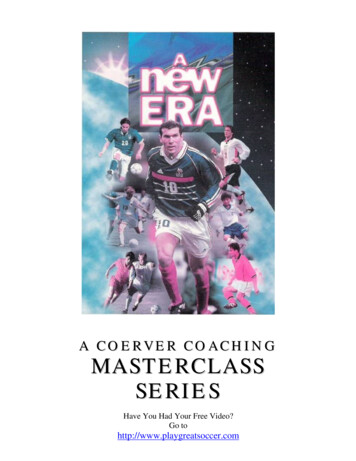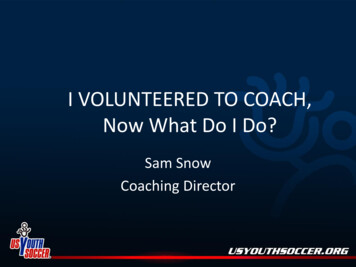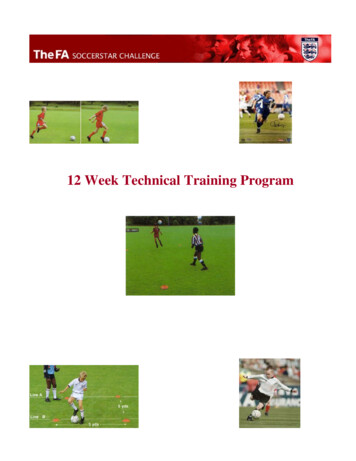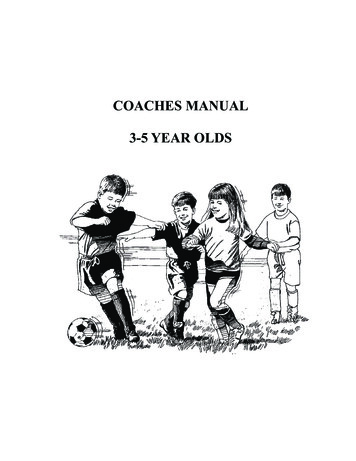
Transcription
COACHES MANUAL3-5 YEAR OLDS
WELCOME TO YMCAYOUTH SPORTSThank you for agreeing to be a coach in the YMCA Youth Sports program. As a YMCAcoach, you will introduce a group of young people to the game of soccer. We ask you to notonly teach your players the basis skills and rules of the game, but also make learning thegame a joyful experience for them. You see, we want them to play soccer not only for thisseason, but also for many years to come, and we want you to have fun teaching soccerbecause we'd like you to help us again next season.Okay, let’s get started. In this guide, you will find essential information about teaching soccer the YMCA way. In the first section, we will explain the philosophy of YMCA YouthSports. Next is your job description for being a YMCA soccer coach, with reminders abouthow to work with this age group. Then we will show you how to teach soccer and provideyou with a season plan and a complete set of practice plans for this age group. In the nextpart we will explain how to teach the YMCA Youth Sports Values. In the last section wewill discuss risk management procedures.Please read the entire guide carefully and consult it regularly during the season. YourYMCA offers you the opportunity to participate in a YMCA Soccer Coaches Course. Thethree and one-half hour course will help you use this approach to teaching soccerand values.
PHILOSOPHY OFYOUTH SPORTS
YMCA OF GREATER HOUSTONPHILOSOPHY OF YOUTH SPORTSWhat we want youth sports to be at the YMCA is stated in our Seven Pillars of YMCAYouth Sports.Everyone Plays. We do not use tryouts to select the best players, nor do we cutkids from YMCA Youth Sports. Everyone who registers is assigned to a team.During the season everyone receives equal practice time and plays at least half ofevery game.Safety First. Although children may get hurt playing sports, we do all we can toprevent injuries. We've modified each sport to make it safer and more enjoyableto play. We ask you to make sure the equipment and facilities are safe and toteach the sport as we've prescribed so the skills you teach are appropriate forchildren's developmental level. We ask you to gradually develop your players'fitness levels so they are conditioned for the sport. We also ask you to constantly supervise your young players so you can stop any unsafe activities.Character Development. Honesty, Respect, Responsibility, Caring, Faith areabout playing by the rules and more. It's about you and your players showingrespect for all that are involved in YMCA Youth Sports. It's about you being arole model of sporting behavior and guiding your players to do the same. Remember, we're more interested in developing children's character through sportsthan in developing a few highly skilled players.Positive Competition. We believe competition is a positive process when thepursuit of victory remains in the right perspective. The right perspective is whenadults make decisions that put the best interests of the children before winningthe contest. Learning to compete is important for children, and learning to cooperate in a competitive world is an essential lesson of life. Through YMCAYouth Sports, we want to help children learn these values, and parents to do thesame.
Family Involvement. YMCA Youth Sports encourages parents to be involved appropriately in their child's participation in our sports programs. In addition to parents helping as volunteer coaches, officials, and timekeepers, we encourage them tobe at practices and games to support their child's participation. To help parents getinvolved appropriately, YMCA Youth Sports offers parent orientation programs.Sport for All. YMCA Youth Sports is an inclusive sport program. That means thatchildren who differ in various characteristics are included in rather than excludedfrom participation. We offer sports programs for children who differ in physicalabilities by matching them with children of similar abilities and modifying the sport.We offer programs to all children regardless of their race, gender, religious creed, orability. We ask our adult leaders to encourage and appreciate the diversity of children in our society and to encourage the children and their parents to do the same.Sport for Fun. Sports are naturally fun for most children. They love the challengeof mastering the skills of the game, playing with their friends, and competing withtheir peers. Sometimes when adults become involved in children's sports they overorganize and dominate the activity to the point that it destroys children's enjoymentof the sport. If we take the fun out of sports for our children, we are in danger of thekids taking themselves out of sports. Remember the sports are for the kids; let themhave fun.
JOB DESCRIPTION
YOUR DUTIES AS A COACHHere are your seven duties as a YMCA soccer coach:Teach the skills and tactics of soccer to the best of your ability. We want you toteach children the physical skills and tactics to play the sport to the best of their ability.Kids value learning these skills and tactics, and they respect those who can help them masterthem. Be a good teacher, but remember that not all children have the same ability to learn. Afew have the ability to be outstanding, many to be competent, and a few to barely play thesport. We ask that you help them all be the best they can be.Help your players learn the rules and traditions of soccer. We will ask you to teachyour players the rules of soccer as they learn the basic skills through the modifiedgames of the sport. Beyond the rules, we’ll also ask you to teach the basic traditions of thesport. By traditions, we mean the proper actions to show courtesy and avoid injury—in short,to be a good sport.Help your players become fit and value fitness for a lifetime. We want you to helpyour players be fit so they can play soccer safely and successfully. However, we alsowant more. We want you to do so in a way that your players learn to become fit on theirown, understand the value of fitness, and enjoy training. Thus, we ask you not to make themdo push-ups or run laps for punishment. Make it fun to get fit for soccer and make it fun toplay soccer so they will stay fit for a lifetime.Help young people develop character. Character development is teaching children thecore values—caring, honesty, faith, respect, and responsibility. These intangiblequalities are no less important to teach than kicking or defensive skills. We ask you toteach these values to children by conducting team circles, which are built into every practiceplan, and demonstrating and encouraging behaviors that express these values at all times.Ensure the safety of your players. You are responsible for supervising every aspect ofyour players’ participation in soccer. Make sure the field is clear of hazardous objectsand that the kids do not engage in activities that might injure themselves or others. Youhave not only a legal but also a moral responsibility to supervise them closely.Help each child develop a sense of self-worth. An essential goal in conducting YMCAYouth Sports programs is to help children gain a strong, positive sense
of their worth as human beings. For each of us, our most important possession is self-worth.Please teach our children soccer in a way that helps them grow to respect themselves andothers.Make it fun. Make learning the game a fantastic positive experience so your playerswill want to continue playing for many years to come.BEING A GOOD COACHJust what makes a good soccer coach? A person who knows the sport of soccer well. If you’re not familiar with the sport, besure to attend the YMCA Soccer Coaches Course and study more about the sport. A person who wants to teach soccer to young people, who cares. Excellent teachers aremotivated, have a positive attitude, and give the time to do the job well. A person who understands young people, who possesses empathy. Empathy is caringabout the young people you teach by showing you understand them.We hope you will do your best to be a good soccer coach for the children on your team. Bydoing so, you can help them develop their spirits, minds, and bodies—the goal for all YMCAprograms.YOUTH SPORTS PLEDGEWin or lose, I pledge before God to do my best, to be a team player, to respect my teammates, opponents and officials, and to improve myself in Spirit, Mind, and Body. Amen.
WORKING WITH3-5 YEAR OLDS
WORKING WITH 3-4 YEARBEHAVIORS OF DEVELOPMENTMotor/Physical DevelopmentLots of energy. Enjoys running,galloping, jumping, dancing.Cognitive DevelopmentImaginativeEnjoys throwing balls, beanbags,etc.Appreciation for diversity,uniqueness in childrenSocial/Emotional DevelopmentParallel play evolves into cooperativePlay.Friendships develop and many developa special friend who they seek for play.ACTIVITIES TO PROMOTE DEVELOPMENTMotor/Physical DevelopmentCognitive DevelopmentProvide lots of physical activities, suchas tricycles, balls, skipping ropes.Enjoys throwing activities such asfrisbees, balls, beanbags, ring toss,bowling, etc.Social/Emotional DevelopmentOpportunities to get togetherwith friends.Cooperative games, rules.Can recognize signs and logos.Understands and appreciates other children’sindividuality.
WORKING WITH 5 YEAR OLDSBEHAVIORS OF DEVELOPMENTLanguage DevelopmentTake things literally. “You can’t have your cakeand eat it too!” Would look around for cake?Motor/Physical DevelopmentVery energetic. Masters skipping,throwing a ball. Catching is stillnot mastered. By this age, it isevident whether they are right orleft handed.At 5 years of age, body is poisedand controlled.Will develop certain interests insports.Physical skill development relatesclosely to development of selfesteem.Cognitive DevelopmentNeed to begin to make some of their owndecisions by planning and managing theirown time.Social/EmotionalPleasant disposition to 5 ½ years.Then can become brash and disobedientover demanding and explosive. Needpatience and understanding.Enjoys helping and receiving praisefor same. Shows pride in achievements.
PRACTICE OVERVIEW
YMCA YOUTH SPORTSPRACTICE SESSIONPLANSWEEK 1Warm-Up (5 Minutes)1. Players free kick or dribble the ball using no morethan ½ the field.2. Players dribble or kick at targets (cones or parents)spread out around ½ the field.Fitness Component (5 Minutes)GENERAL FITNESSFollowing the warm-up, gather your players and brieflydiscuss the fitness concept for that practice. In this firstpractice your fitness topic will be more general, but infuture practices you will often discuss more specificconcepts and issues such as safety, flexibility, healthyhabits, and more.Key Idea: General FitnessGather children about 10 to 15 feet away from a goal orcone. “Everyone jump 10 times. Our muscles help usjump. When you use your muscles a long time withoutgetting too tired, it improves your endurance, whichmeans you can run longer without getting tired. Now runreally fast to the goal and back.” Wait for them to return.“Running strengthens your heart and lungs. Now touchyour toes; try to keep your fingers there while I count.Stretching makes you flexible, like a rubber band. Whenwe play soccer, our bodies run, kick, and move. It makesour bodies stronger and improves our fitness, whichmeans we can run and play longer and faster. Having
WEEK 1good physical fitness is important for soccer and for being healthy. Atevery practice we will talk about fitness in our fitness circles.”Skills/Drills (15 Minutes)Dribbling – Teach dribbling as a series of “little kicks” meant to controlthe ball. Discuss which part of the foot (outside/inside) you use todribble.Accuracy Game – Bowling for Cones – Set up 3 cones like bowlingalley pins. Place players 10 feet away. Have them kick the ball at thecones seeing how many they can knock down. Have parents ready toreset cones for next player.Red Light/Green Light – Freeze Game – Have all players with ballson the goal line. Have them start to dribble the ball towards center field.When you blow the whistle they freeze. Make sure all players havecontrol of their ball and stop. If they lose control, they go back to thegoal line.Game/Play (15 Minutes)KICKING AT CONESThe players should be placed in a circle, approximately 20 feet wide.Place 6 cones inside the circle in various positions. Give the players threeballs and tell them that they must kick the balls and knock the conesdown. Parents can assist by returning the balls that get kicked out of thecircle. You could time them and try to improve the amount of time toknock down all the cones. This will teach kicking accuracy and receivinga pass.
WEEK 1INTRO TO VALUES (10 Minutes)TEAM CIRCLEKey Idea: YMCA Five Core ValuesGather players into a circle. “This season we’ll talk about the five values ofthe YMCA. These are values that all good people and teammates have.Number one is CARING. Tell me how you can show caring to others? Byhelping someone when they fall? Great! Number two is HONESTY. Howcan you show that you’re honest? How about if you tell your parents aboutsomething that you accidentally broke? Good! Number three is RESPECT.Do you know what respect is? One way to show respect is by listening toadults when they speak to you, just like you’re doing now. Number four isRESPONSIBILITY. If you’re responsible, you will pick up after yourself ifyou make a mess. Don’t wait for others to pick up after you. Number five isFAITH. One way to show faith is when you believe in yourself that you cando something hard – like make a goal in a soccer game – and you practicehard. When you believe in yourself, you’ll almost always reach that goal.”Ask them to share ways that they show the five values in their lives. “Goodteammates show these values to each other. We’ll talk more about thesev values during the season.
WEEK 1YMCA YOUTH SPORTSPRACTICE SESSION PLANS3-5 Year OldsWarm-up (5 minutes)Fitness Component (5 Minutes)Skills Drills (15 Minutes)Game/Play (15 minutes)Team Circle (10 minutes)
YMCA YOUTH SPORTSPRACTICE SESSIONPLANSWEEK 2Warm-Up (5 Minutes)Have players practice close dribbling. Tell players“Keep the ball close when you run”, as they practice.Also, tell players that you will blow the whistleoccasionally during practice. When you blow thewhistle, they should stop and put a foot on the ball toshow they have it under control.Fitness Component (5 Minutes)CARDIOKey Idea: Cardiorespiratory FitnessChildren gather into a group. "Everyone hold one handup and make a fist. Squeeze your fist tightly, and then letgo. Keep tightening and letting go." Children continuefor 10 counts. "Your heart is a special muscle thattightens and relaxes just like your fist is doing. Yourheart is about the size of your fist. Let's put our fists overour chests. Every time it tightens, or beats, your heartpumps blood all over . Children continue for 10 counts.When you run during soccer, your heart beats faster. Thebeat slows down when you slow down. Let's run withhigh knees for 15 counts while we count together. Stopand feel your heart beat by putting your hand over yourchest." Model for players. "Running strengthens yourheart and lungs and improves your fitness."
WEEK 2Skills/Drills (15 Minutes)KICKING/TARGETSEgg Hunt:Kids line up on one goal line. Scatter balls (eggs) on the field. Releasekids to get eggs into the opposite goal (basket). Key is to have at least asmany balls as kids is better.Game/Play (15 Minutes)RELAYS/KICKINGPlayers should be in two single file lines. Place 4 cones in a line directlyin front of them. Cones should be approximately 10’ apart. The firstplayer in each line should attempt to dribble the ball around the cones anddouble back to the line. After each player has had a turn, start a relayagainst each other. Large team practices can use three or four lines. Try tomaximize the amount of time the players will touch the ball.
WEEK 2RESPONSIBILITY (10 Minutes)TEAM CIRCLETEAM CIRCLEKey Idea: RESPONSIBILITYGather players into a group. “I want us all to pretend we are eggs.Eggs have shells that can break. What would happen if we bumpedinto each other if we were eggs? Right. We would all crack andbreak. Let’s move around the field and still pretend we’re eggs. Trynot to bump into each other or you’ll break!” Continue this activity forabout one minute. “We were all good and careful not to bump intoeach other! So our shells didn’t break! That was awesome! You werein charge of your self, or responsible for yourself, when you weremoving around. When we are careful not to bump into each other, weare showing responsibility for our space and other players’ space. Thisshows responsibility during practices and games.” You are responsibleto your team and to yourself to be a part of the team.”
WEEK 2YMCA YOUTH SPORTSPRACTICE SESSION PLANS3-5 Year OldsWarm-up (5 minutes)Fitness Component (5 Minutes)Skills Drills (15 Minutes)Game/Play (15 minutes)Team Circle (10 minutes)
YMCA YOUTH SPORTSPRACTICE SESSIONPLANSWEEK 3Warm-Up (5 Minutes)SOCCER SHAPESEach player with a ball. Using different parts of the body(foot, elbow, head, etc.) players make shapes with theball as ordered by the coach. (i.e. “using your right footon the ball, make a circle”).Fitness Component (5 Minutes)MUSCLE STRENGTH/ENDURANCEKey Idea: Muscular Strength & EnduranceGather children into a circle. "Everyone find your ownspace so you don't bump your neighbor. You are goingto run in your own spot for 30 seconds, then stop.Ready? Go!" Time children and verbally let them knowthe time remaining; stop them at the end of the time."What part of the body did we just use the most when weran?" Encourage their responses. "When we play soccer,whichpart of your body do you use the most?" Wait for theirresponses. "Muscles in our body help us move our legs.Playing soccer will help our leg muscles get stronger andgrow bigger."
WEEK 3Skills/Drills (15 Minutes)DRIBBLINGThe first skill needed to play soccer is dribbling, which is moving andcontrolling the ball using only the feet. Players can use dribbling tomove the ball down the field for a pass or shot, to keep the ball from theopposing team, or to change direction.Players must be able to use both the insides and outsides of their feet todribble. To dribble with the inside of the foot, the player turns the footout, then pushes the ball forward while moving. To dribble with theoutside of the foot, the player must turn the foot in, then push the ballslightly forward or to the side.Players may have trouble dribbling at first. Have them start by walkingand dribbling. Once they can do that, ask them to speed up theirdribbling pace. Insist that they look up as they dribble and not down atthe ball. If they always look down, they are likely to have the ball stolenby an opponent or may not see a teammate who is open for a pass.Encourage players to use either foot to dribble--this will make it easierfor them to protect the ball from opponents.As your players improve, have them dribble against an opponent. Beingmarked (guarded) by a defender will require them to vary their speed,change direction, and shield the ball. Have them prepare for defensivepressure by practicing speeding up and slowing down as they dribbleand by dribbling around towels or cones.Here are some keys to dribbling: Push the ball softly in the desired direction if you are dribblingclose to defenders. Look up and watch for other players. Keep the ball close to your feet. If it is too far ahead, other players can steal it. Shield the ball from opponents. Run at a speed at which you can control the ball. If you are dribbling fast, push the ball out several feet ahead andsprint to the ball.
WEEK 3ErrorLetting the ball get away from the player while dribbling.Correction Keep the ball underneath the body, close to the feet. Nudge the ball gently in different directions, never letting it get morethan a stride's length away. Determine whether the grass or ball require adjustments. A highlyinflated ball or extremely short grass will cause the ball to roll faster andfarther.Conduct relays with two sets of lines. Players must dribble the ballaround parents (or cones.Game/Play (15 Minutes)RELAYS/SCRIMMAGESet up four goals with cones. Goals should be approximately 8 feetwide. Pair up the players. Ask parents to be goalies. Players will try toscore against the parents. They should be encouraged to pass to eachother before trying to score. After approximately 30 seconds they shouldrotate to another goal and repeat. Keep track of how many goals theyscore.
WEEK 3RESPECT (10 Minutes)TEAM CIRCLETEAM CIRCLEKey Idea: RESPECTGather players into a single file line near two cones about 10 feet apart.“I am going to walk down the line two times. Remember how it feelseach time I pass you.” Walk down the line and nod to each player.Repeat this, but now tell each player “good game” or “way to playtoday” and shake their hand. “ Which time that I passed by made youfeel better?” Ask the players to stand near a cone that represents theiranswer. “Shaking hands and saying “good game” are importanttraditions that show we appreciate our opponents’ play in the game. Itshows respect for your opponents.” Divide the team in half and havethem practice an end-of-game “respect ritual.”
WEEK 3YMCA YOUTH SPORTSPRACTICE SESSION PLANS3-5 Year OldsWarm-up (5 minutes)Fitness Component (5 Minutes)Skills Drills (15 Minutes)Game/Play (15 minutes)Team Circle (10 minutes)
YMCA YOUTH SPORTSPRACTICE SESSIONPLANSWEEK 4Warm-Up (5 Minutes)Repeat Relay games from week 3 practice.Fitness Component (5 Minutes)SAFETY EQUIPMENTKey Idea: Safety Equipment & RulesBring a small piece of cardboard or a clipboard that canbe used as a shield. Get one child to demonstrate. Provide a ball and have the child kick the ball at you at a medium effort. "Watch where the ball goes when Juliakicks it." Allow the ball to hit your legs. Then put theboard in front of you, between you and the child kicking.Have the child kick again. "Now watch where the ballgoes. This board is just like a shin guard that we wear onour legs. Wearing shin guards protects our legs just likethe board protected my legs from the ball." Give eachplayer a turn kicking the ball. "Can you think of otherways to be safe that you should remember to do whenyou play soccer?"
WEEK 4Skills/ Drills (15 Minutes)PASSINGPassing is another essential skill, as it allows the team to maintain possession of the ball and create scoring opportunities. Passes should beshort and crisp; an opposing player is likely to steal long or slowpasses. However, players should avoid using passes that are too hardand difficult to control. When passing under pressure, the playershould pass, then move into space quickly.Players should kick short passes with the inside of the foot. Here is thecorrect technique for short passes: Plant the non-kicking foot alongside and near the ball. Square up the hips and shoulders to the teammate for whom you intend the pass, and turn out the kicking foot. Swing the kicking foot straight at the center of the ball. Follow through by swinging the kicking let well beyond the point ofimpact with the ball, in the direction of the teammate to whom youare passing the ball.Sometimes a game situation will call for a player to make a long pass toa teammate across the field. The best way to make a long pass is to loftthe ball through the air using the top of the foot. This is the correcttechnique for lofting passes: Plant the non-kicking foot slightly behind and to the side of the ball. Point the toes of the kicking foot down, and kick the ball with theshoelace area. Kick under the ball. Watch the kicking foot contact the bottom half of the ball and lift itoff the ground.Players should learn to use the outside of the foot to pass to the side,but this technique may be uncomfortable and difficult for them to perform. They also may have difficulty passing with the top of the foot orshoelace area (also called a power pass), as they tend to use their toesinstead. Because of these problems, you may want to have young players master the short passes before they learn these other types of passes.
WEEK 4Error Detection and Correction for PassingError Lack of accuracyCorrection Plant the non-kicking foot beside the ball with the toes pointed toward the teammate who will receive the pass. Square your shoulders and hips to the receiver. Keep the kicking foot firm throughout the kicking motion. Follow through with the kicking foot.Skill Practice Introduce, demonstrate, and explain how to move to support a teammate with the ball. Practice moving to support a teammate with the ball.DescriptionPairs--Tell partners to practice getting the ball from one end of the fieldto the other without running with the ball. Ask, "How do you do it?"They should answer "Pass and move forward." After they practice passing the ball and score at the other end, they come back.Game/Play (15 Minutes)SMALL-SIDED SCRIMMAGESet up four goals, similar to the previous week. However, instead ofparent goalies, this will be a 2 on 2 scrimmage. Parents need to assist. 2players will play defense and 2 players will play offense. After severalminutes of play, they should switch from offense to defense.
WEEK 4HONESTY (10 Minutes)TEAMCIRCLETEAMCIRCLETEAMCI RCLEHONESTYKe y I de a : FAITHHONESTYGet the players into a group near two cones about 10 feet apart. “Canyou touch the ball with your hand in soccer? Even if it’s an accident?Those of you who think it’s okay to touch the ball, stand by this cone.Those of you who thinks it’s not okay, stand by this cone.” Wait forplayers to choose. Then ask them why they chose the cone they did.“Touching the ball with your hand, even if it’s an accident, is a foul.What should you do if this happens? Those of you who would justkeep playing, stand by this cone. Those of you who would raise yourhand and give the ball to the other team, go stand by that cone.” Waitfor them to pick their cone. “It’s important to be honest about fouls. Ifyou touch the ball with your hand, even if nobody sees it, raise yourhand and give the ball to the other team.”
WEEK 4YMCA YOUTH SPORTSPRACTICE SESSION PLANS3-5 Year OldsWarm-up (5 minutes)Fitness Component (5 Minutes)Skills Drills (15 Minutes)Game/Play (15 minutes)Team Circle (10 minutes)
YMCA YOUTH SPORTSPRACTICE SESSIONPLANSWEEK 5Warm-Up (5 Minutes)Break groups into 3 or 4 players. Have them pass theball around the group with either foot.Fitness Component (5 Minutes)HEALTHY HABITSKey Idea: Healthy HabitsGather children into a circle. "When your body doesn'teat healthy foods and get enough sleep, it moves slowly.Let's pretend we have no energy to move because wedidn't eat enough healthy foods or get enough sleep."Begin to move slowly and encourage children to follow.Move extremely slowly. "Everyone stop. Now I amgoing to fill your bodies up with healthy foods." Act outgiving them foods. "Pretend we're sleeping. When I say'Wake up!' you can move faster because you haveenough energy and enough rest. Wake up and movefaster. Stop! What are some other healthy habits youhave learned?" Examples: daily exercise, brushing teeth,saying no to drugs, no smoking. "
WEEK 5Skills/Drills (15 Minutes)PASSING / RECEIVINGHave them find a partner, one ball per pair. This will take a littlewhile so you might tell them to come back from the break with apartner and a ball before you dismiss them.First have them pass the ball back and forth while standing about 3yards apart. They will look hopeless.Stop them and ask what part of foot to use for short accurate passeson the ground (Answer is inside of foot, show them what you mean;that part of the foot between the heel and ball of foot.) Have themresume. Point out that a pass is no good if it can't be received bytheir teammate. Ask what that means (Answer on ground, withinreach, not to hard, not too soft, when it is expected, for example itdoes no good to pass to a teammate's back, or to one picking dandelions.)Stop them and ask them how to receive the ball (Answer: cushionthe ball so it slows and is left in front of you so you can step forwardto pass it. Don't let them stop the ball under their foot, or so closethat the ball is stuck between their feet and must be moved before itcan be kicked. Tell them the ball should be keep moving. Now youwill also have to tell them to back up after they pass the ball or elsethey will end up too close together.In soccer, receiving and controlling a passed ball is called receiving. A player can receive the ball with just about any part of thebody--the foot, the thigh, or the chest. Here are some key components inreceiving: Get in front of the ball. Watch the ball. Cushion the ball. Keep the ball near the body.At this level, you will be teaching players how to receive with thefoot, the thigh, and the chest. To receive the ball on or near theground with the foot, the player should stand in front of the ball andextend a leg and foot out to meet it. After the ball reaches theplayer's foot, he or she should pull the leg back to slow the ball and
WEEK 5relax the foot when the ball makes contact. This technique is calledcushioning the ball. If a player does not cushion the ball, it will bounceaway from the foot and the player will lose control. It will bounce awayfrom the foot and the player will lose control. Receiving with the insideof the foot provides the most surface area and is best for inexperiencedplayers. Eventually, players should learn how to receive with the outside and top of both feet. Note that players receiving with the top of thefoot should also use the lower shin and front part of the ankle to cushionthe ball.Error Detection and Correction for Receiving With the FootError: Losing control of the ball off the foot.Correction: Contact the bottom and side of the ball with the inside of the foot-midway between the heel and toes. Cushion the impact of the ball by dro
coach, you will introduce a group of young people to the game of soccer. We ask you to not only teach your players the basis skills and rules of the game, but also make learning the . Players free kick or dribble the ball using no more than ½ the field. 2. Players dribble or kick at targets (cones or parents) spread out around ½ the field.

